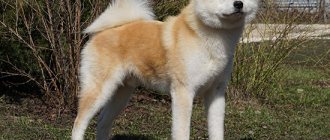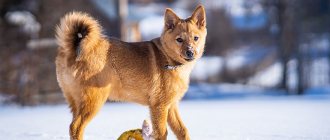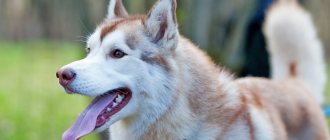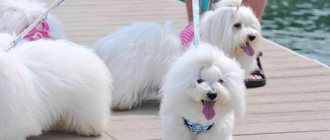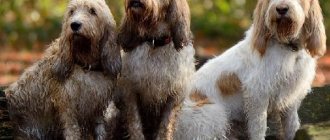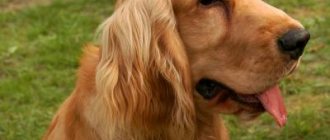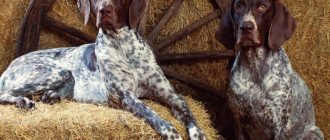Features and description
When we hear “ German Shepherd breed ” the first thing that comes to mind is loyalty, endurance and courage. Such associations exactly correspond to objective reality. Representatives of the breed have gone through a long development stage. It is said that their descendants were timber wolves.
A person actively involved in the issue of breeding efficient and beautiful dogs in the 19th century was Max Emil. Before the modern representative of the breed was born, this breeder crossed many popular shepherd dogs with each other.
The result of such experiments was a dog with good working abilities, but an unpresentable appearance. The selection continued. Only at the end of the century did the world become acquainted with a loyal, strong and very cute dog.
Interesting fact! Almost immediately after being bred, the German Shepherd became the national symbol of Germany.
The representative of the breed is universal in nature. It can be used by a person as a security guard, bodyguard, rescuer, guide, cattle breeder and simply a faithful comrade. He copes well with each of these types of “work”.
He is distinguished by responsibility and love for people. If you are used to a person, you will never betray him or leave him in trouble. He might give his life defending him. He will not be afraid even of weapons. This dog is observant and careful. She will never attack a person without a reason, but if he seems dangerous to her, she attacks. She is very smart and capable of making independent decisions.
The main feature of the animal is the presence of a deep sense of justice. Despite its warlike appearance, it is very vulnerable and affectionate. Strives to honestly serve a person, but in return requires a lot of attention and care. Being ignored greatly upsets him.
This set of service and psychological qualities of the dog served as the reason for its exploitation at customs. She has an excellent sense of smell, good observation and responsibility. All this helps to quickly identify a criminal, perhaps even a drug dealer.
Nature has not deprived the dog of artistic talent. The German Shepherd regularly takes part in filming advertisements for dry food, collars, veterinary hospitals, etc. Moreover, she is also invited to appear in TV series and films. In cartoons, it symbolizes courage and bravery. Children love this dog because it is friendly with them. She always inspires confidence and is capable of affection. Very contactable.
Education and training
Of course, being one of the smartest breeds, the German Shepherd is easy to train. They must begin to be trained from early childhood, but absolutely without cruelty, with patience and constant encouragement for their efforts. The purpose of training a puppy is to show that following the owner’s commands is very healthy, and not the commands themselves. Otherwise, the dog will grow up stubborn, harmful and disobedient. And it will be much more difficult to learn.
It is FORBIDDEN to tie the puppy and lock it in separate rooms and premises.
German Shepherd Puppy
German Shepherds are not aggressive by nature. The only case of aggression is in defense of its owner and his family, and then the dog must first be trained to do this. The sooner a dog is socialized, the better, as they begin to understand your emotions well and understand when a friend has come to see you or when you are worried about a guest. In the second case, the dog will also be extremely attentive and suspicious of the guest.
Breed standard
The German Shepherd dog is medium in size and weight. Her body is elongated, and her bones are rather dry. Height at withers - from 59 to 65 cm, weight - from 32 to 38 kg. The weight of some large males reaches 40-42 kg, this is not considered a deviation.
Gives the impression of a strong beast. The muscle corset is very developed. In purebred German Shepherds, the lower part of the body should be inclined towards the ground. This is a feature of their exterior. The fact is that the dog’s hind legs are quite long, and the front legs are much shorter. Therefore, it seems that he is practically dragging them along the ground. The dog's hip muscles are very strong. In the same zone there are strong bone cartilages.
The tips of the paws have hard black pads. The claws are medium in length and dark. Over time, they wear down, especially if the animal moves a lot. The chest is well defined, the abdomen is sunken. The tail is long, reaching to the ground. When the dog is calm, it hangs down, and when excited, it rises to the level of the waist.
The shepherd has a rather large head, the shape of the skull is round. The forehead is well defined. The distance between the ears is not wide. The eyes are round, with light brown irises. There are long thick black eyelashes. The nose is large and dark.
Important! Pedigree German Shepherds should have 5 moles on their face: 4 on the cheeks and one on the neck (throat area).
The coat of such dogs can be long, short or medium in length. But it must be direct. There is a thick undercoat. The fur on the muzzle, paws and belly is short, but on the sternum, back and withers it is the longest. There are many colors:
- Black-and-white.
- Zonal.
- Pure black.
- Pure white.
- Reddish-gray.
- Grey-white.
Of course, the German Shepherd in the photo in most cases is depicted as black-haired. This color of her coat is the most common. It is extremely rare to find a purely white or black representative of the breed. The black-backed dog's back is black, as is the top of its tail and the tip of its muzzle. There are also dark marks on the dog's cheeks. There is delicate white fur on the lower thigh. By the way, shepherd puppies are born dark, becoming lighter around 4 months.
Description of the breed
The German Shepherd is a service dog with a balanced character, active behavior and capable of various training. The German Shepherd is best trained if it has one owner, but it can handle changing owners without problems. Thanks to the police past. She was specially trained in such a way that every patrol police officer could command her.
German Shepherds. Mom with puppy
This is undoubtedly a smart dog. Even a child can raise it and therefore it is perfect as a house dog. By the way, she is great with children. The German Shepherd is in third place in the ranking of the smartest breeds, compiled by doctor and professor of psychology Stanley Coren (Canada). We have prepared for you the entire list with a description and photo of each breed - look at the smartest breed and the most difficult to train?
The German Shepherd is versatile. It can serve equally well as a companion dog, guard dog, protective dog, detective dog, service dog and guard dog.
Character
Those who were the owner of a German shepherd rarely get dogs of other breeds. There is an explanation for this. The fact is that a representative of this breed is not only efficient, but also very smart. His intellectual abilities are amazing.
This dog always understands what mood its owner is in, and he can also adapt to it. It is well trained, but is willful. Every smart dog needs proper and consistent training.
If you don’t teach her the rules of behavior from childhood, she will become angry and difficult to control. The German Shepherd is very self-confident, knows that it is smart and strong, so it often becomes self-centered. Quite proud, prone to independence. But, despite all these shortcomings, she is affectionate and responsible.
The love of this breed for its owners is limitless. He is filled with joy when he looks at them. When household members pet or kiss the dog, he rejoices. She never skimps on her feelings and strives to demonstrate her love and tenderness to her loved ones. In everyday life he is very affectionate. Can sit next to people for hours. Doesn't like loneliness or isolation. Prefers to be the center of attention.
Naturally strong and resilient. He is prone to competition, because he knows his own worth and can challenge any opponent. He is ready to fight for the attention and love of his owner by any means. If he gets another dog, the shepherd will bully it, maybe even bite it. It is important to pay attention to this in time and correct her behavior.
It is a mistake to think that a representative of this breed is exclusively a “working” pet. Yes, he will faithfully guard his household and the territory in which they all live, but this does not prevent him from showing tenderness and affection. It's cute to watch a large guard dog roll over on its back in front of a person, inviting him to pet him.
Note! When a dog bares its belly, it shows its trust in you. This part of her body is the most vulnerable, therefore, showing it, she says: “Man, I’m not afraid, but I love you, you can stroke me.”
Thanks to its full range of positive character traits, the German Shepherd is an ideal family dog. She serves her family faithfully, looks after the children responsibly, and loves to play and have fun. But you should not expect that such a dog will be friendly with every person, especially with strangers.
Do not forget that, first of all, this is a guard dog that protects and protects the members of its pack. There is no point in teaching her how to guard, since she herself knows and feels how to do it.
This is why the German Shepherd will express aggression towards every person standing outside its territory. But as soon as the owner appears and greets the guest, the dog’s attitude towards him will immediately change.
He will understand that since the owner is friendly with the stranger, then he does not pose a threat. She always relies on him, but sometimes she becomes obstinate and decides on her own. By nature he is merciful. Protects those who are weaker than him. Never gets involved in conflict without reason. Seeks the owner's approval. Loves sports and active recreation.
Breed standard: characteristics of the German Shepherd breed
The breed standard makes it easy to determine the external characteristics of the animal and what its behavior should be.
- General form . The German Shepherd is medium in size. She is a little squat and has an elongated body. The length of the body can be 10%, or even 15-17%, greater than the height. The body is muscular and strong.
- Wool . The average length of the coat becomes shorter on the paws, and in the neck area it becomes very long. The color can be a combination of black, red-brown, golden, beige-brown and gray. A dark mask on the muzzle and a black nose are required. White coat color is considered unacceptable.
- Head. The length of the head and muzzle is almost the same. The transition from the forehead is not pronounced. The muzzle itself is wedge-shaped. Lips tightly compressed. The eyes are almond-shaped and dark in color. They are not convex and are medium in size. Light colors are frowned upon as they change the look of the German Shepherd. The dog's ears are always erect. Sagging or broken ears are not acceptable.
- Paws . The front legs should be level and parallel to each other. The angle between the paw and the shoulder blade should ideally be 90 degrees, but up to 110 degrees is allowed. The hind legs are slightly set back. They have wide and powerful hips.
- Tail . It hangs gently and reaches the middle of the hock. The fur on it is quite long.
- Movements . The nature of the movements reveals the animal to be a trotting dog. The shepherd's head is slightly tilted and his tail is raised.
- Behavior . This is one of the most important characteristics in the standard. The German Shepherd is invariably endowed with such qualities as attentiveness, kindness, obedience, and balance. The German dog must have a fighting instinct.
Adult dog size
German Shepherds are medium in size. So males have a height of 60-65 cm, and females - 55-60 cm. The weight of males is 30-40 kg, and females are much lighter and weigh 22-32 kg.
Lifespan. How long do they live?
The life expectancy of representatives of this breed is 9-13 years.
The breed has a predisposition to diseases, which should be taken into account by the owner of the German Shepherd.
- Volvulus . Like all large breeds, this disease also occurs in German Shepherds.
- Dysplasia of the hip or elbow joints . It is treated in different ways.
- Intervertebral disc diseases . May also occur in young animals.
- Eye diseases . This can be cataracts, corneal dystrophy, lens luxation and many other anomalies.
- Skin problems . These include pododermatitis, furunculosis, seborrhea, pyoderma.
- Allergy . May present with different symptoms.
- Cardiovascular diseases . The predisposition is more common in males.
- Plague . Dogs with black coats are more likely to get sick.
Care and maintenance
The German Shepherd is in great need of exercise. She is strong, but can weaken if she is not trained regularly. The dog loves to run cross-country or sprint. Can live both in a house and in an apartment. But keep in mind that you need to walk with her outside the house a lot and often.
It is much easier for those who live in a private house. A dog who prefers active recreation can live comfortably on the street. It's better for him to sleep in a booth. In winter it can be insulated with hay or cotton wool. There is no need to worry that your pet will catch a cold. It has a very dense undercoat that warms well. By the way, in the summer he actively sheds.
We do not recommend putting the “German” on a chain. This is a very smart and strong dog that needs to be given freedom of movement. We also do not recommend locking her in an enclosure for a long time. Of course, it is better for the animal to sit there if there are a lot of people in the yard. Get him accustomed to the enclosure in the first days of your acquaintance.
The dog's fur is very dense and can get tangled, so it needs regular brushing. You can purchase a separate comb for it. It must be cleaned periodically with alcohol for disinfection purposes. If your pet has too long fur on his thighs, it is better to cut it off in the summer. Without this, it will become tangled and dirty.
Bathing such a dog too often is highly discouraged. It is advisable to do this as it gets dirty, but not more than 2 times a year. The best time of year for swimming is summer. The dog should be soaped, rubbed and rinsed with clean water. She will shake off the excess water herself and begin to move, which will allow her to dry faster.
If you are forced to carry out this procedure in an apartment, you will have to wipe it with a towel. If your dog's nails grow too quickly, they will have to be trimmed. Otherwise, he will start to hurt himself when he washes himself or scratches himself.
You also need to take care of the animal's teeth. Plaque will form on their surface; it can simply be removed with a human toothbrush. Large ears are wiped with cotton wool from the inside to remove wax. Well, the last moment is washing. If you notice souring in your dog’s eyes, wipe his face with a damp cloth and rinse with water.
Caring for a German Shepherd
German Shepherd
We have already written about the necessary lifelong mental and physical training, but this is one of the most important requirements for the dog to be happy and, most importantly, not get sick. In general, German Shepherds have virtually no tendency to get sick. With good food, necessary training and annual mandatory vaccinations, the dog will be healthy.
Longhaired German Shepherds
Wool. Both long-haired and smooth-haired shepherds need to be brushed as often as possible. In long-haired dogs, the fur becomes matted and the undercoat needs to be removed, especially in warm weather. Mats cause the dog discomfort while moving, which can affect both the quality of training and the dog’s mood. Brushing also cleanses the coat of dirt and dust.
It is recommended to wash your dog NOT more than 2-3 times a year. Otherwise, the dog loses the special protective oils on its coat and the coat becomes very dark. Germans are washed with a special shampoo for them. After washing, the coat should be dried thoroughly and drafts should be avoided while the dog is drying.
Ears. This breed has a weak point in terms of infections. It is recommended to clean your ears weekly with cotton wool and constantly monitor them to ensure there is no redness, discharge or odor.
Nutrition
A German Shepherd puppy needs a complete, balanced diet. If fed incorrectly, he will grow up weak, sad and distant, and his coat will not have shine. It is important that the baby receives amino acids and proteins every day. These nutrients are found in milk, cereals and meat.
A complete list of foods that should be fed daily to a puppy from 2 to 8 months:
- Buckwheat or wheat porridge.
- Chicken (preferably raw).
- Milk or semolina.
- Cucumbers, broccoli, lettuce, tomatoes.
- Bananas, strawberries, apples, melon.
Never feed your pet raw sea fish, as it contains bones and possibly parasites. It is also recommended to permanently eliminate pork, smoked lard, sharp bones (especially beef), chocolate, biscuits and marmalade from his menu. Eating such foods can cause digestive dysfunction in dogs. Dry food can be given to an adult “German” over 1 year old.
Reproduction and lifespan
A reliable guard, a loyal friend and just a beautiful pet - all this describes the German Shepherd perfectly. She lives from 12 to 14 years, but only with good care. Breeders planning to breed these types of dogs should be well aware of their standard. It is also advisable to breed individuals of the same color. Only in this case can one raise offspring that are correct in every sense.
A male dog can be the same age as a female dog, the main thing is that each of them is over 1.5 years old. It is not advisable to have dogs over 7 years old. Each of the potential parents must be psychologically stable and of high breed.
They are mated in the male's territory. This happens when the bitch is in heat. If she becomes pregnant, then by 8-10 days after reproduction her tummy will be noticeably rounded. You can expect puppies in 70 days (plus or minus 3 days).
Price
If you dream of becoming the owner of one of the most popular dogs in the world, we recommend going to a kennel for her. No, you don’t have to go to Germany; there are high-bred “Germans” in almost every country in the world, including Russia. The price of a German Shepherd from a kennel is from 15 to 25 thousand rubles. It depends on the age of the puppy, as well as on its compliance with the standard.
The cost from private breeders is lower (from 6 to 12 thousand rubles). If you do not need full compliance with the dog’s breed standard and its pedigree, we recommend saving money and using their services. However, before purchasing, be sure to inquire about the vaccinations that the puppy received.
Education and training
Let's start with the main thing: if you want to raise a “German” who is successful in work and social terms, then get ready for the fact that it will take a long time to train him, especially in the first year of his life. It is believed that a working dog is more successful if it is raised by 1 person. By the way, it is he who is perceived by her as the owner.
It is necessary to build a hierarchical and trusting relationship with her. She must understand that she is in a subordinate position. You cannot gain the authority of a service dog by force. You need to prove your superiority to her humanely. Teach her the rules of behavior in the house, be consistent, do not spoil her and do not allow her to misbehave with impunity.
When you bring your Shepherd puppy into your home, it is a good idea to let him explore the area. It is important that he sniffs every corner. This is how he adapts to new conditions of detention. Control this process. Don’t let your baby get scared of something; in this case, protect him. For example, you can pick up your puppy or lean down to pet him.
Teach commands early, within a week of home socialization. The representative of the breed is definitely not deprived of intelligence, so he learns new things quickly and effectively. When training classic teams, don't forget to treat him with something tasty as a reward. Don't let him get overtired. If the dog gets tired every time, he will develop a negative attitude towards training.
The next important point is leash walking training. Remember, a leash is a connection between you and your pet. He must learn to walk next to his owner and not be distracted. To do this, put a collar on your pet, attach a leash and practice walking together near your home. Avoid meeting other dogs.
Important rule! Never take your German Shepherd outside until he is at rest. You can sit with her near the front door for a few minutes, waiting for her level of arousal to subside.
It is also impossible to allow the development of so-called food aggression in a shepherd dog. This phenomenon involves the dog showing anger while eating food. Some service dogs try to protect their food from theft in this way.
But a representative of the breed should be trusted by members of the household. A simple way to prevent food aggression is to pet a young dog while it eats. This way she will get used to the fact that there are kind people nearby who do not pose a threat and will begin to calmly eat in their presence.
Possible diseases and methods of treating them
You cannot call a German Shepherd a weak and sickly dog, but there are factors that will certainly undermine its health. The main one is unhealthy diet. If your pet sleeps a lot, defecates frequently and refuses to eat, this is a warning sign. His digestion was probably disrupted.
A sick dog should be taken to an animal clinic and seen by a specialist. In most cases, digestive dysfunction in dogs is treated by taking sorbents. The veterinarian will prescribe the medicine and determine the dosage. You can give sorbents to your pet yourself at home.
Almost all German Shepherds have a genetic defect - weak, inelastic leg joints. When the dog is not injured, the pathology does not manifest itself in any way, but if it falls, for example, on ice, it will easily damage a limb. Painkillers will help the animal.
The German Shepherd is not only a fearless bodyguard, but also a loyal and affectionate friend. She will always come to the aid of people who love her and will never leave them of her own free will.
Dog behavior during heat
Each period of German Shepherd estrus is characterized by its own characteristics and changes in behavior and mood. At the proestrus stage, the female changes her behavior and becomes too calm or, conversely, as active and playful as possible. The dog begins to be interested in males, but does not allow them to approach him, since he is not yet ready for mating. In this way, the bitch creates conditions for future mating, otherwise she will not allow the male to approach her, will begin to be capricious and will stop obeying.
Estrus is the most favorable period for mating, when the dog does not resist it. At this phase, the dog is characterized by a pose with a raised pelvis and a tail set to the side. When the lower back is touched, the dog sits up and puts back its tail. During these few days you should refrain from walking your dog; if this is not possible, then walk it only on a leash.
During metestrus, the dog is less active and loses interest in males. Regardless of whether the female becomes pregnant or not, the possibility of the release of progesterone, the so-called “pregnancy hormone,” cannot be ruled out. A large amount of progesterone provokes the development of false pregnancy. There is no need to do anything; after some time, all the signs will go away on their own.
Return to content

